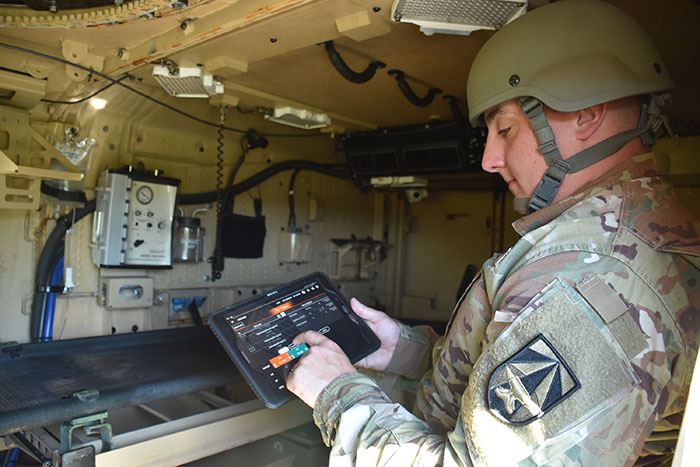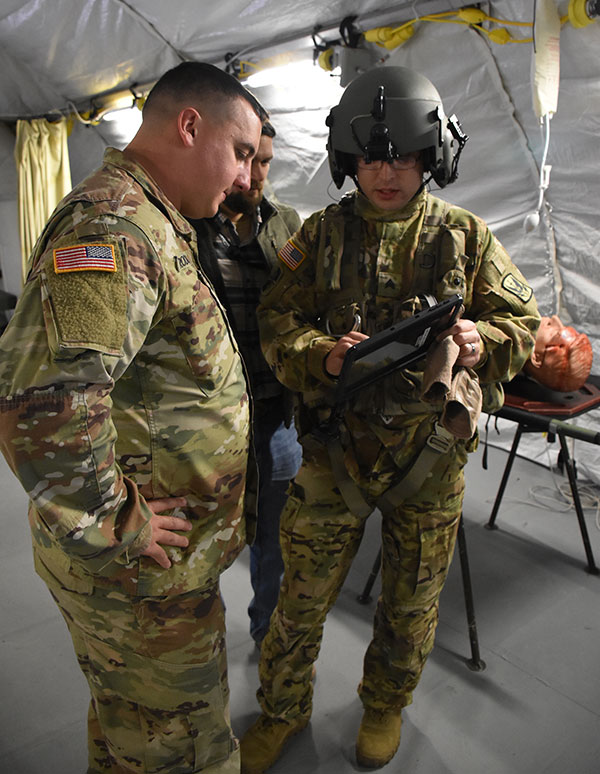Army's MEDHUB System Proven Effective for Operational Use

The U.S. Army Medical Materiel Development Activity's Warfighter Health, Performance, and Evacuation Project Management Office initiated operational exercises in the fall of 2019 to assess the capabilities of its Medical Hands-free Unified Broadcast system, better known as MEDHUB, and the results were highly favorable. This innovative device is a medical communication platform that utilizes a handheld electronic tablet to share patient information between medics and hospitals during medical evacuations.
The operational assessment was conducted by personnel from the U.S. Army Medical Department Board, which is the Army's sole independent operational test and evaluation agency for medical-related materiel and medical information management and information technology products. Per the results of the assessment, the functionality of MEDHUB was shown to support the medical mission, and the device was proven to be usable in an operational environment. This assessment is the final one required before the Milestone C decision, which is the Defense Acquisition System production and deployment decision point for materiel release and fielding.
Through integrating U.S. Food and Drug Administration-approved wearable medical devices, the MEDHUB system seamlessly collects, stores and transmits non-personally identifiable patient information from point-of-injury to the receiving military treatment facility or hospital. Traditionally, ground and flight medics use a handwritten Tactical Combat Casualty Care, or TCCC, card to document the vital signs, injuries, medications, and treatments of patients during MEDEVAC situations. The TCCC card is intended to stay with the individual during transport, and updated along the way by the multiple medics providing care from one point to the next. However, when the scenario is exacerbated by multiple casualties and intense conflict – and in most cases, handled by only one medic with perhaps as many as six patients – completing critical documentation can become a highly stressful process.
Austin Langdon, a former Army flight medic with the Maryland National Guard, serves as the subject matter expert for evacuation on the MEDHUB team. Langdon is very familiar with the pressure associated with intense MEDEVAC missions. Having been deployed with the U.S. Marine Corps to Helmand Province, Afghanistan in 2012, he experienced his first mass casualty event within 45 minutes of landing at the Forward Operating Base. He was the first all-Army-trained flight medic to perform a blood transfusion in the back of a military helicopter, as part of the Vampire program. Needless to say, Langdon understands the potential of the MEDHUB system in helping to properly treat patients and save lives.

"MEDHUB doesn't replace the way medics triage a patient, or how they conduct rapid trauma assessments – it changes the way we document medical intervention," he explained. "When the medic is task-saturated, and focused on their critical patient, it is difficult to write legibly on the patient's TCCC card in a vibrating helicopter with an indelible marker. The MEDHUB tablet allows the medic to record administered drugs, or any lifesaving interventions, electronically on a touch screen that can capture all of the necessary documentation, which is transmitted to the hospital and can be scanned into the patient's Electronic Health Record."
"But it also helps with drug dosage calculations, per the Standard Medical Operating Guidelines," he continued. "MEDHUB provides the proper dosage for the individual based on the patient's weight, which increases the accuracy of drug dosages and reduces the workload of the medic in high-stress situations. The real key is its ease of use, and its reliability – it does what I need it to do, when I need it, without extra steps."
In addition to Langdon, who is the third Army-trained flight medic to serve as part of the MEDHUB product team, the group's software expert is a trained paramedic. Staff selection has been very intentional along the way, to ensure a proper mix between scientists, engineers, and experts in medical evacuation. As military ground and flight medics will be the primary user group for MEDHUB, their feedback remains critical to testing and fielding the device, which is why the recent operational assessment was so important in advancing the unit towards ultimate fielding.
The two-week operational assessment, which took place at the Air Force Medical Evaluation and Support Activity at Fort Detrick, Maryland, included staff members from the MEDHUB product team, Army ground medics from the U.S. Army Aeromedical Research Laboratory, and Army flight medics and personnel from the Maryland Army National Guard.
Army Sgt. Jordan Rodgers, a combat medic from USAARL in Fort Rucker, Alabama, was among those selected to participate in the exercise. Not only was he immediately impressed with the MEDHUB unit, he was also amazed with how quickly he could learn and understand the software program.
"I've only been working on [MEDHUB] for a few days now, but I already see the benefits it can offer medics," said Rodgers. "From my perspective, I feel it would make my job easier, because I can input the patient's TCCC card information onto an electronic tablet, and in real-time send all of this info to the MTF I'm en route to – so it helps to prep that hospital with everything they need to do, before I even arrive." When asked what he liked best about the MEDHUB system, Rodgers replied without hesitation, "I really like the real-time updates to the MTF. As I'm taking vitals, and reassessing my patient, the hospital is getting that updated information instantly."
"The program is very simple to learn, and very simple to use," he added.
Army Sgt. Patrick Fogle, a flight paramedic with the Maryland National Guard, agreed with this evaluation by Rodgers. Having been with the National Guard for 13 years, Fogle completed the Army Critical Care Flight Paramedic program in 2019 and was excited to participate in this operational assessment.
"I think MEDHUB is a very big help in documentation, even in the long-term, for patients when they come back, to make sure they're given the correct disability," he said. "But it's equally helpful during the actual transport as well, and I really like how it helps with medication dosage conversions. It doesn't matter what type of drug we're administering – it gives you the correct dosage for that particular drug, based on the weight of the patient."
Fogle also agreed the real-time updates are one of the best features of the MEDHUB system.
"Right now, if we're in country, I have to get on the radio with the hospital, or else one of the pilots do, which shifts our focus away from what we really should be doing," he said. "With the pilots, they take their eyes away from scanning the environment outside of the aircraft, and with me, it takes my eyes off the patient. But with MEDHUB, we don't have to do that."
While he offered additional praise for the MEDHUB unit, Fogle said he did find a few things he would like to see "tweaked" with the system, and conveyed his thoughts to members of the MEDHUB product team – and this is exactly the type of feedback that product manager Wang was hoping to receive.
"We're very grateful that the active-duty medics from USAARL and the Maryland National Guard came out to support this exercise," said Wang. "Having the end-user here to actually demonstrate this capability helps us discover new and better ways to train other users, and to develop this capability for the final fielded unit, which will allow us to build the best product for our Warfighters."
"The operational assessment allowed us to work end-to-end, to see how the users will utilize MEDHUB, and how the Army network can support this important capability," he continued. "This was really a follow-up on some things we weren't able to fully demonstrate at our last assessment, due to limitations of the network. However, we've already proven a large part of its capability, and the assessment allowed us to validate additional capabilities of the MEDHUB system."
Wang and his team are very pleased with the success of MEDHUB to date and the positive results thus far, and they look forward to achieving the Milestone C mark in 2020. The group anticipates MEDHUB's use as an approved system for the military within the next few years, as this will help to advance current medical capabilities from analog to digital. Although the initial end-user will be military medical personnel, the device eventually may fall into the hands of civilian medical providers as well. Regardless of who will use MEDHUB, the system should help to alleviate the burden and stress of medical documentation and drug treatment during patient evacuation, both on and off of the battlefield.
This article has been updated with new information since its initial publication in the Fall/Winter 2019 issue of Combat & Casualty Care Magazine, published by Tactical Defense Media, Inc., located here.













